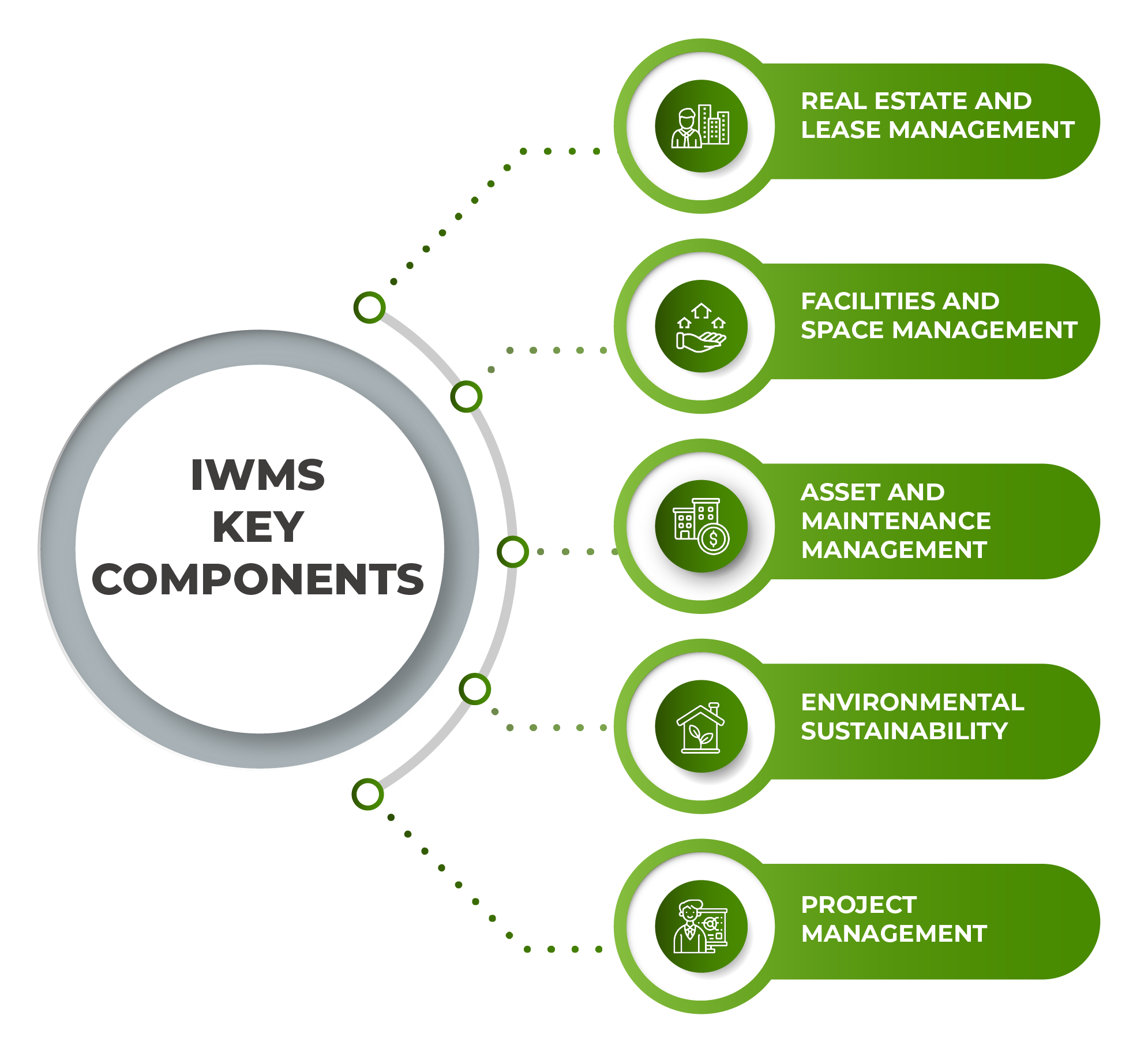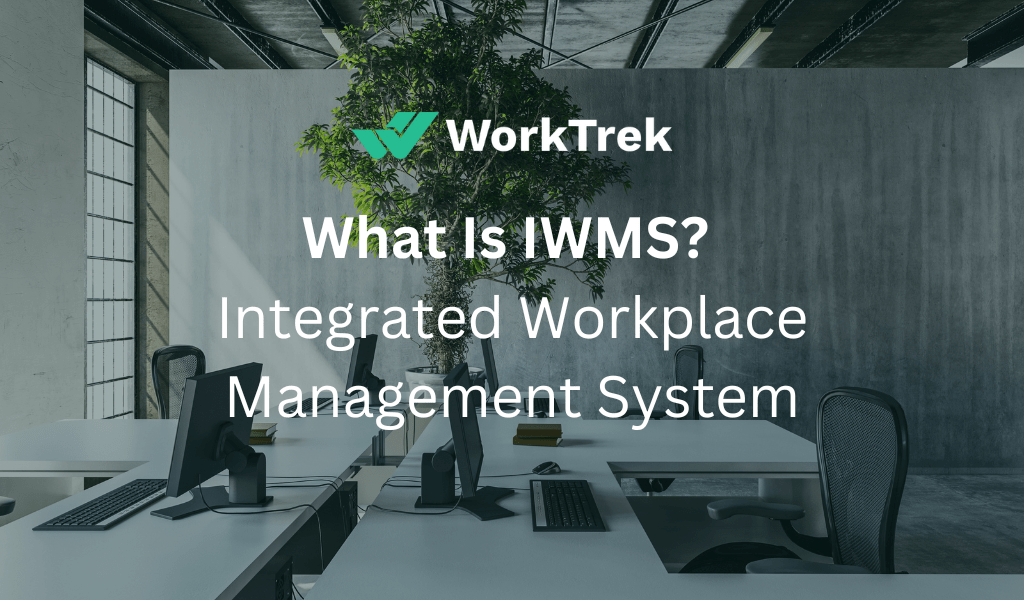Get a Free WorkTrek Demo
Let's show you how WorkTrek can help you optimize your maintenance operation.
Try for freeWhat Is IWMS? IWMS stands for Integrated Workplace Management System. It’s a software platform used by organizations to manage various aspects of their real estate portfolio, infrastructure, and facilities. IWMS platforms typically offer modules for managing space utilization, lease administration, maintenance, sustainability initiatives, capital projects, and other related functions.
These systems provide a centralized database and tools for optimizing space allocation, reducing costs, improving operational efficiency, and supporting strategic decision-making related to facilities management and corporate real estate. IWMS solutions are commonly used by large enterprises, government agencies, educational institutions, and other organizations with complex facility management needs.
Modern workplaces require effective management to maintain uptime and productivity. Managing a workplace includes a wide range of tasks such as maintenance, security, asset management, space planning, etc. An efficient workforce depends on the smooth running of back-end processes.
With approximately 82% of businesses experiencing unplanned downtime each year, disruptions affect the entire organization and its employees, with a significant impact on sales and profits.
To address this, an integrated workplace management system (IWMS) brings together a collection of software technologies designed to solve common workplace challenges.
IWMS brings together asset management, building and energy performance, space planning, and other work management functions in one integrated platform.
Here’s everything you need to know about IWMS.

Workplace Management: Definition and Key Challenges
Workplace management is a global concept that encompasses the management of services, devices, processes, and technologies that enable employees to work, collaborate, learn, and innovate.
The goal of this people-centered approach to management is to make the work environment work for employees, improving their well-being and user experience.
By establishing and maintaining a good work environment, companies can increase the efficiency and productivity of their employees. Good management practices help achieve these goals while optimizing costs while adapting to changing needs.

Performance and Workplace
IWMS is a concept that goes beyond the traditional functions of facilities management by improving employee performance and collaboration. It’s more than a simple support service, it’s a strategic tool that can help organizations achieve their goals. It represents significant added value.
Workplace management is a continuous improvement process aimed at achieving the highest level of performance in the corporate workplace. A common denominator among today’s most productive organizations is their recognition of the role workplace management plays in employee engagement and productivity.
It can be applied at many different levels, from managing several workplaces to managing a large, internationally distributed real estate portfolio. In any event, it covers all processes to improve workplace performance levels, from strategic planning to the operational use of equipment, including safety, maintenance and catering.
What Is The Integrated Workplace Management System (IWMS)?
The combination of data with business processes in an integrated software solution is an important condition for identifying initiatives to improve profitability and quality, to then implementing them and finally monitoring them continuously. These software solutions are called Integrated Workplace Management Systems (IWMS).
Integrated Workplace Management System (IWMS) is the globally recognized name for software solutions that support facility management and property management processes. This term was launched in 2004 by Gartner. The IWMS solution is described by Gartner as an enterprise-grade software platform integrating five important functional areas from a single technology platform and a single centralized database. These functional areas are:
- Real Estate and Lease Management
- Facility and Space Management
- Maintenance Management
- Project Management
- Environmental Sustainability

The History of IWMS
Leading technology research firm Gartner first used the term “integrated workplace management system” in 2004 to describe an enterprise-wide program that can manage multiple functional areas. Gartner describes the concept of integration as a “single technology platform, single data repository.” The rise of the internet in the late 90s and early 2000s made integration and such platforms more possible – and even more important.
IWMS Functional Areas
The ideal IWMS software integrates multiple functional areas of the workplace that could not have been combined or worked simultaneously, but which now absolutely must work together.

Resource Management
Organizations are moving towards more sustainable practices, and IWMS software supports this trend. Plants are able to measure, analyze and reduce resources and waste consumption – such as water consumption, energy consumption and greenhouse gas emissions. An IWMS enables facility management to leverage capabilities to improve sustainable practices, capture performance metrics and plan for better energy management.
Real Estate Portfolio Management
Corporate real estate professionals can use IWMS software to track items such as leases, contracts, appointments, and disclosures. As the real estate landscape continues to change in the post-pandemic world, it’s critical that you have access to data about how all your properties are being used. It’s much harder to get a complete picture of your property when you’re tracking this information across multiple spreadsheets. An IWMS can help you consolidate, visualize and report on everything so you can make the right long-term planning and investment decisions.
Facility Management
An IWMS helps you optimize asset and maintenance processes and activities. These include:
Maintenance Schedule:
Proactively schedule and automatically assign preventative maintenance to your equipment. With all equipment tracked in one system, you can easily view part information and work history for each asset, saving technicians time searching for data or manually entering information into multiple systems.
Work Orders:
Easily submit work orders to fix faulty equipment and track maintenance or repair work on one platform.
Asset Health Assessment:
Manage asset assessment data to better understand a building’s physical condition—including age, structure, and condition of individual rooms and equipment.
Having data for all assets in one place makes it easier to spot short-term and long-term trends. With cloud-based IWMS software for mobile devices, your technicians can access equipment information directly from the palm of their hands.

Capital Project Management
Capital project management typically involves the design and implementation of building extensions or renovations, asset exchanges, and blueprints, all coordinated on the IWMS to provide design, capital management, cost, procurement, scheduling, bidding, critical path analysis, and documentation support.
Sustainability and Energy Management
More and more companies are looking to reduce their carbon footprint, enhance their sustainability efforts and monitor energy consumption.
However, this is becoming increasingly challenging. The Verdantix research also found that as organizations push for mixed work schedules, building occupancy rates will be more volatile. This in turn increases the pressure on facility teams to optimize their heating and cooling equipment to accommodate these fluctuating and low utilization conditions.
Effective IWMS software helps companies analyze their consumption patterns and spot spikes and anomalies in data more easily. This means you can better optimize, predict and reduce energy consumption. Read also, a guide to plant operations management.

How To Get The Most Out Of IWMS Software?
The potential advantages of IWMS software are enormous. However, before making a decision and committing to a system, it is strongly recommended that you detail the benefits you expect from it in order to create an effective specification.
To help you, here are the top 5 key benefits typically expected from IWMS software.
True Knowledge
Many firms know this: a lack of visibility into real estate portfolios in a broader sense leads to significant risks in terms of cost, compliance, and continuity. If you find yourself in this situation, an IWMS solution will help you a lot in planning maintenance, supplier management, understanding the value and characteristics of your assets, and more.
Such a tool allows you to gain an overview by creating a standardized database for all space, equipment, and property management processes: you know exactly which areas you occupy, and you can track subcontractors’ work in detail.
Guaranteed Compliance
Ensuring compliance with laws and regulations is a growing headache for facility managers. Whether it’s about safety, maintenance, or the environment, standards are becoming more numerous and more stringent, and it’s hard to keep up with their evolution.
Therefore, organized and easily accessible documentation is critical to ensuring compliance with their facility and being able to demonstrate this in the event of an audit or incident.
IWMS software typically provides features that ensure compliance with standards and provide all employees who need them with the necessary files to take into account when performing their tasks.

Better Space Management
In many companies, workplaces are often underutilized, sometimes without managers even realizing it. The use of IWMS allows on the one hand a reliable diagnosis of the occupancy of offices, workplaces, and conference rooms, and on the other hand, implements another measure to reduce the creation area available to employees and thus also costs.
Space Monitor
Diagnosis includes analyzing and identifying inefficiencies, unnecessary losses, bottlenecks, or budget overruns. Furthermore, in addition to initial diagnosis, IWMS software can evaluate and continuously improve processes to increase productivity and customer or user satisfaction.
Decision Support Made Simple
It is becoming increasingly important for managers of organizations to be able to make informed and quick decisions. To do this, they must be able to rely on data that is accurate, comprehensive, reliable, and quickly available.
If they have an integrated workplace management solution, all this data is available to them thanks to various types of reports, analytics, and dashboards. They can even access forecasts to help them make a decision.
Cut Costs
All of the above benefits have an impact on cost. While it’s hard to quantify them all, some studies show a 10-15% reduction in facility costs, a 5-8% reduction in process costs, and a 5-8% reduction in rental costs. Typically, building stock and installation costs can be saved by 10% to 20% due to data control and transparency.
By purchasing an IWMS software solution, a business or organization can make significant advances in space organization and management and significantly reduce its operating costs. This approach needs to be prepared, built, and shared in order to maximize its effectiveness by choosing the right tools and involving all future users. Consider reading, how can CMMS software save you money.

Hybrid Work And The Evolution of Facility Management Software
Facilities management solutions have changed dramatically over the past few decades – even more so in recent years. Especially due to the emergence of hybrid working, IWMS software has also become one of the most valuable new technologies in the workplace. Of course, hybrid offices are becoming more and more common in today’s world. The management of their workplaces has also become increasingly demanding.
Today, FMs are often tasked with improving the workplace experience, improving space utilization, and/or introducing flexible work arrangements such as hot-desking or hotel-style offices. To do this, they need to be able to quickly and easily update floor plans, as well as collect and aggregate data on how the workspace is actually performing. In other words, you need a state-of-the-art IWMS solution.

CAFM vs. IWMS: What’s the Difference?
Computer Aided Facility Management (CAFM) software typically focuses on a unique perspective of space and asset management – fully optimized for facility management and integrated to some extent with workplace service requests. This is ideal for smaller businesses and facilities that don’t need more complex management software and prefer to just manage services and track requests. CAFM programs also tend to span multiple platforms, not just one.
IWMS solutions are ideal for large organizations and enterprise-level companies that monitor multiple areas of management. These systems exist on a single platform that facilitates demand management, planning ideal strategies, managing energy and resources, capital projects, real estate, lease management, and facility maintenance.

The Future of IWMS Solutions
As jobs become more complex, you can rest assured that your IWMS solution can keep up.
As we’ve already mentioned, the world is moving to more complex work arrangements. Not surprisingly, the best IWMS solutions help simplify this complexity and make dynamic spaces more manageable.
Hybrid and distributed work are harder to optimize and harder to see what’s really going on in your workplace.
Additionally, IWMS systems can be expected to increasingly take on the task of improving the employee experience.
For example, helping employees book the right type of workspace can help remove barriers to productivity and engagement.
IWMS software solutions are a convenient and hassle-free way to track and manage every element of your facility and business with a single facility management system. It is easy to use and flexible enough to adapt to the growing and changing needs of your business. While there’s nothing wrong with computerized facilities management software, your business may need more. This is where IWMS software comes in, providing a way to track and manage workplace management more efficiently.
In summary, IWMS is a powerful tool that can be customized to meet the specific needs of your organization. Enjoyed reading this blog? Consider reading, why your CMMS may not meet expectations.










